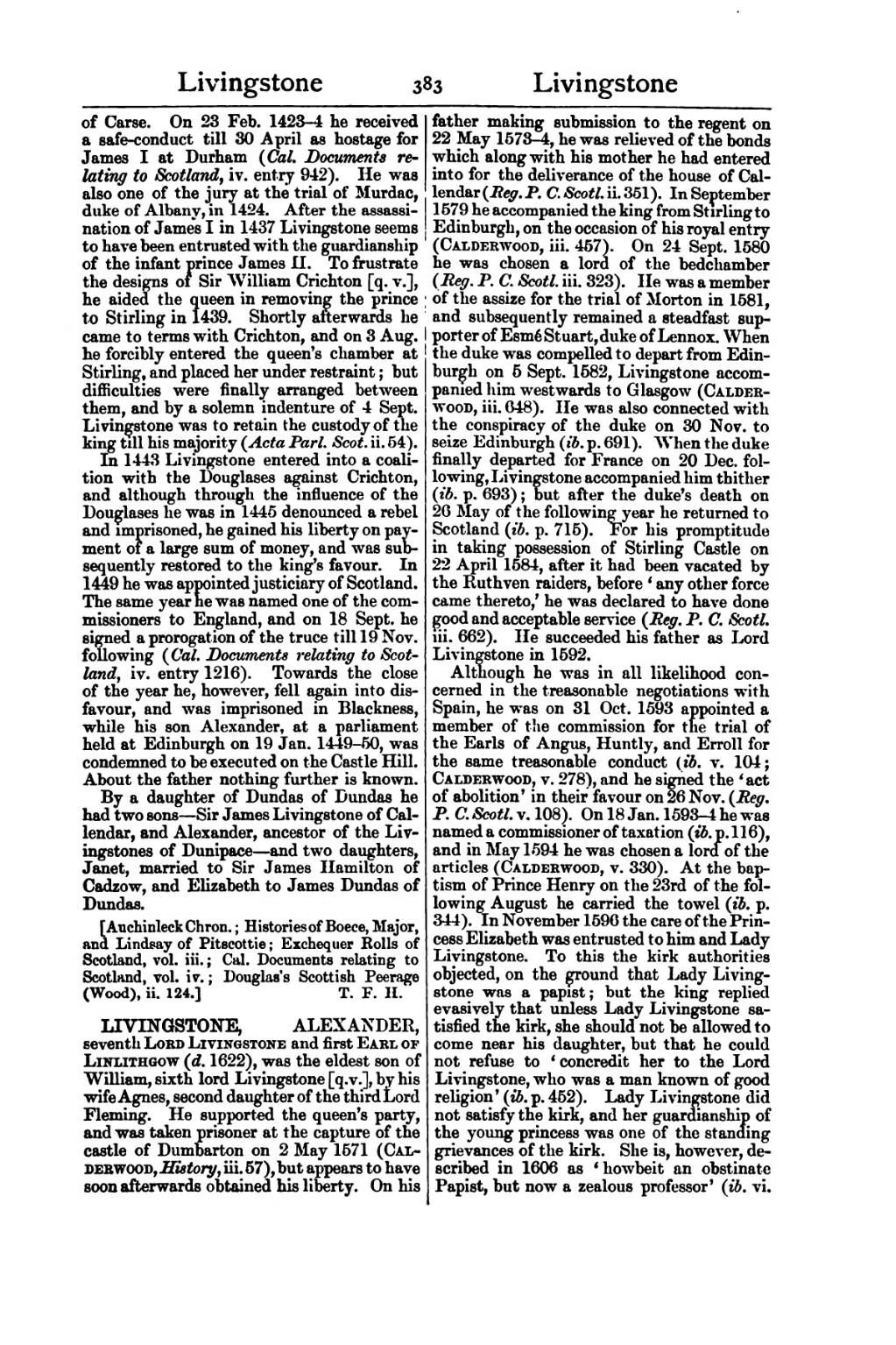of Carse. On 23 Feb. 1423–4 he received a safe-conduct till 30 April as hostage for James I at Durham (Cal. Documents relating to Scotland, iv. entry 942). He was also one of the jury at the trial of Murdac, duke of Albany, in 1424. After the assassination of James I in 1437 Livingstone seems to have been entrusted with the guardianship of the infant prince James II. To frustrate the designs of Sir William Crichton [q. v.], he aided the queen in removing the prince to Stirling in 1439. Shortly afterwards he came to terms with Crichton, and on 3 Aug. he forcibly entered the queen's chamber at Stirling, and placed her under restraint; but difficulties were finally arranged between them, and by a solemn indenture of 4 Sept. Livingstone was to retain the custody of the king till his majority (Acta Parl. Scot. ii. 54).
In 1443 Livingstone entered into a coalition with the Douglases against Crichton, and although through the influence of the Douglases he was in 1445 denounced a rebel and imprisoned, he gained his liberty on payment of a large sum of money, and was subsequently restored to the king's favour. In 1449 he was appointed justiciary of Scotland. The same year he was named one of the commissioners to England, and on 18 Sept. he signed a prorogation of the truce till 19 Nov. following (Cal. Documents relating to Scotland, iv. entry 1216). Towards the close of the year he, however, fell again into disfavour, and was imprisoned in Blackness, while his son Alexander, at a parliament held at Edinburgh on 19 Jan. 1449–50, was condemned to be executed on the Castle Hill. About the father nothing further is known.
By a daughter of Dundas of Dundas he had two sons—Sir James Livingstone of Callendar, and Alexander, ancestor of the Livingstones of Dunipace—and two daughters, Janet, married to Sir James Hamilton of Cadzow, and Elizabeth to James Dundas of Dundas.
[Auchinleck Chron.; Histories of Boece, Major, and Lindsay of Pitscottie; Exchequer Rolls of Scotland, vol. iii.; Cal. Documents relating to Scotland, vol. iv.; Douglas's Scottish Peerage (Wood), ii. 124.]
LIVINGSTONE, ALEXANDER, seventh Lord Livingstone and first Earl of Linlithgow (d. 1622), was the eldest son of William, sixth Lord Livingstone [q. v.], by his wife Agnes, second daughter of the third Lord Fleming. He supported the queen's party, and was taken prisoner at the capture of the castle at Dumbarton on 2 May 1571 (Calderwood, History, iii. 57), but appears to have soon afterwards obtained his liberty. On his father making submission to the regent on 22 May 1573–4, he was relieved of the bonds which along with his mother he had entered into for the deliverance of the house of Callendar (Reg. P. C. Scotl. ii. 351). In September 1579 he accompanied the king from Stirling to Edinburgh, on the occasion of his royal entry (Calderwood, iii. 457). On 24 Sept. 1580 he was chosen a lord of the bedchamber (Reg. P. C. Scotl. iii. 323). He was a member of the assize for the trial of Morton in 1581, and subsequently remained a steadfast supporter of Esmé Stuart, duke of Lennox. When the duke was compelled to depart from Edinburgh on 5 Sept. 1582, Livingstone accompanied him westwards to Glasgow (Calderwood, iii. 648). He was also connected with the conspiracy of the duke on 30 Nov. to seize Edinburgh (ib. p. 691). When the duke finally departed for France on 20 Dec. following, Livingstone accompanied him thither (ib. p. 693); but after the duke's death on 26 May of the following year he returned to Scotland (ib. p. 715). For his promptitude in taking possession of Stirling Castle on 22 April 1584, after it had been vacated by the Ruthven raiders, before ‘any other force came thereto,’ he was declared to have done good and acceptable service (Reg. P. C. Scotl. iii. 662). He succeeded his father as Lord Livingstone in 1592.
Although he was in all likelihood concerned in the treasonable negotiations with Spain, he was on 31 Oct. 1593 appointed a member of the commission for the trial of the Earls of Angus, Huntly, and Erroll for the same treasonable conduct (ib. v. 104; Calderwood, v. 278), and he signed the ‘act of abolition’ in their favour on 26 Nov. (Reg. P. C. Scotl. v. 108). On 18 Jan. 1593–4 he was named a commissioner of taxation (ib. p. 116), and in May 1594 he was chosen a lord of the articles (Calderwood, v. 330). At the baptism of Prince Henry on the 23rd of the following August he carried the towel (ib. p. 344). In November 1596 the care of the Princess Elizabeth was entrusted to him and Lady Livingstone. To this the kirk authorities objected, on the ground that Lady Livingstone was a papist; but the king replied evasively that unless Lady Livingstone satisfied the kirk, she should not be allowed to come near his daughter, but that he could not refuse to ‘concredit her to the Lord Livingstone, who was a man known of good religion’ (ib. p. 452). Lady Livingstone did not satisfy the kirk, and her guardianship of the young princess was one of the standing grievances of the kirk. She is, however, described in 1606 as ‘howbeit an obstinate Papist, but now a zealous professor’ (ib. vi.
